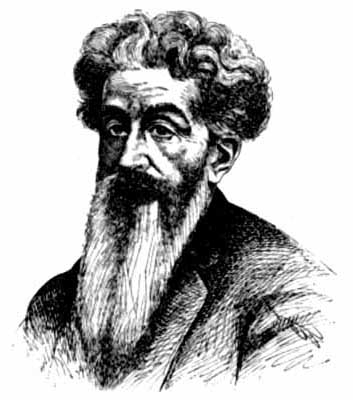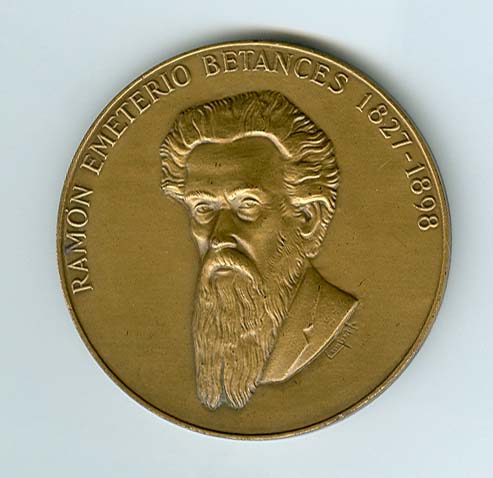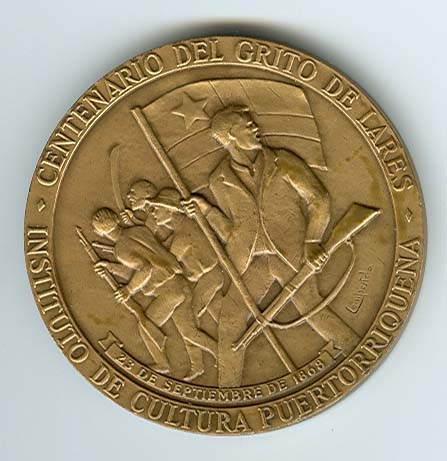
Bronze Medal 1968 - Obv: bearded portrait of Betances, Ramon Emeterio Betances 1827-1898 around above, Rev: Puerto Rican revolt of 1868, three armed men march towards Lares, one holding flag Centenario del Grito de Lares / Instituto de Cultura Puertorriquena / Compostcla [engraver]
Metallic Art Co. NY incused on rim


Born on 8 April 1827 to a wealthy landowner, Betances received his medical degree from the University of Paris in 1855. Upon his return to Mayagüez, he founded a hospital and worked to save Puerto Ricans from the ravages of a cholera epidemic. That year he and others founded a clandestine society dedicated to the liberation of the slaves. The Spanish colonial government exiled him for these activities several times. In 1867, he fled to the present-day Dominican Republic where he founded the Revolutionary Committee of Puerto Rico. The following year he organized an armed expedition that led to the abortive insurrection of September 23,1868 known as the Grito de Lares.
The "Grito de Lares" is Puerto Rico's first and only cry for Independence. On September 23, 1868 between 600 to 1000 men, mostly Puerto Rican born and from the west of the Island, revolted for Independence from Spain. Of the arrested most were innocent jíbaros their only guilt was being passive victims of the political regime. The citizens of the Capital as well as the wealthy were indifferent to the independence movement. The men were poorly armed without aid, protection or training. The revolt which was planned for September 29th began instead on the 23rd as a result of betrayal.
On the evening of the 23rd the most daring met at the farm of Manuel Rojas in Pezuelas, Lares. Led by Manuel Rojas this group of men marched towards Lares. They were able to take Lares without any resistance before the Spaniards became aware of the revolt. The group proceeded to form a provisional government declaring an independent Puerto Rico Republic. The new President was Francisco Ramírez, Aurelio Méndez was the Government Minister, Clemente Millán was the Justice Minister, Federico Valencia was the Minister of the Treasury, Manuel Ramírez was the Secretary of State, Bernabé Pol was the Secretary. The following day they marched to San Sebastián where the Spanish militia awaited them and the rest is history.
Within 24 hours the revolt, which was twelve years in the planning, was defeated by the Spanish government. Of the participants 20 escaped, 8 died in action, 7 were tried by the War Council. Four months later Spain declared a general amnesty. No one was executed or kept in jail over 4 months. However 80 died in jail from yellow fever. The majority of the insurgents were Puerto Ricans and represented diverse socio-economic and racial levels. 551 were ultimately charged. Dr. Betances was allowed to go to France in exile.
The reasons for the defeat were: the betrayal of the plan; Betances' inability to arrive with the weapons or ammunitions; and the fact that the general citizenry was lukewarm to the movement. The reason for the insurrection were: poverty, slavery, taxation, lack of opportunity, and military rule.
The revolt was not a total loss. Shortly after the revolt Spain gave the Island many liberal reforms. It extended to Puerto Rico some of the liberal constitution that it had allowed during the war in Spanish America. Puerto Rico received provincial status and Spanish Citizenship was granted to the criollos. Abolition of slavery began slowly in 1869 and was completed in 1873 giving freedom to some thirty two thousand slaves. (In 1827 there were approximately four times the number of free Africans in Puerto Rico than slaves. Partly due to the creole's distaste for slavery, often freeing their own slaves.) The libreta system was also canceled during the same year. Some of these concessions were canceled or changed later on but nevertheless the insurrection was fruitful and resulted in an improved lifestyle for the Puerto Ricans.
El Grito de Lares is now immortalized. In 1969 Governor Luis A. Ferré, a statehood supporter, declared September 23rd a National Holiday. Lares was declared a Historic Site by the Institute of Puerto Rican Culture. Lares is known as the birthplace of Puerto Rican Nationalism.
Diccionario Histórico Bibliográfico Comentado de Puerto Rico

Mutt will donate this medal as he has others to the ANS